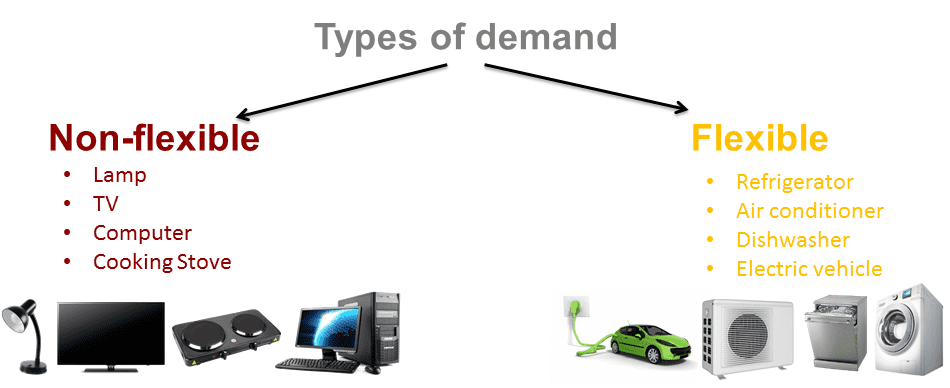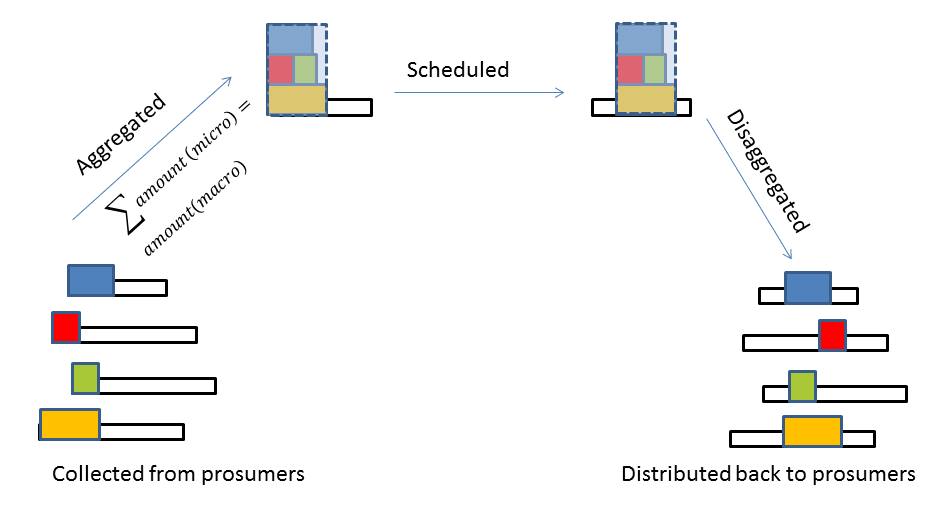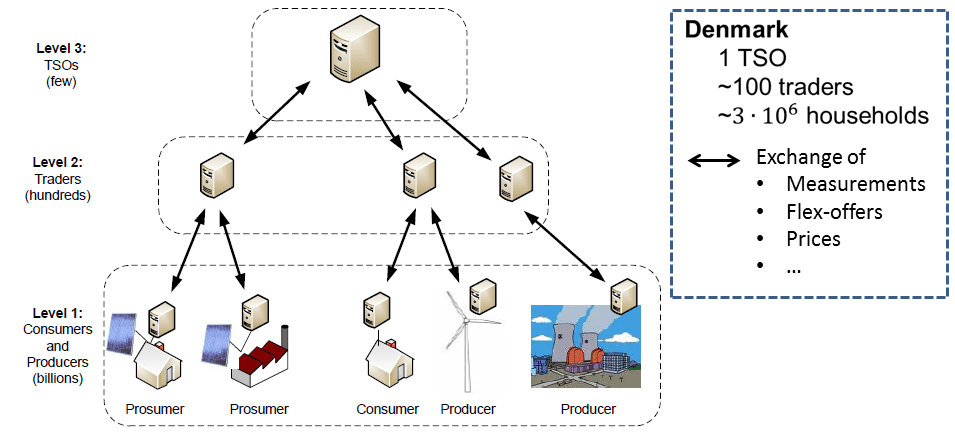FlexOffers
FlexShape aims to maximize the value of flexibility by making it explicit using the revolutionary "Big Energy Data" FlexOffer concept. The FlexOffer concept and technology has been developed at the Center for Data-intensive Systems (Daisy) at Aalborg University since 2010 in the large EU FP7 projects MIRABEL and Arrowhead, and the large Danish Totalflex project supported by Energinet.dk's ForskEL program. Recently, FlexOffers form the core of the GOFLEX project (starting in November 2016) which was top ranked in a recent Horizon 2020 call on integrating renewable energy in distribution grids. In total, these projects have received grants of over 85 mio. Euros. Information about FlexOffers and related material can be found here.
What are FlexOffers?
Individual electricity consumers (e.g., households or SMEs) can often time-shift their electricity consumption or switch electricity consumption profiles for some of their local devices (e.g., heat-pumps, electric vehicles, and dish-washers):  A so-called FlexOffer offers a standardized and unified way of describing flexibility from a wide range of such flexible devices (resources). Irrespective of the device type, electrical energy amounts and associated flexibilities can be explicitly captured using a FlexOffer. For example, energy amounts and associated flexibilities in time and energy amount for charging the battery of a single electric vehicle between 10pm and 8am can be represented by a single FlexOffer, shown below in its basic form:
A so-called FlexOffer offers a standardized and unified way of describing flexibility from a wide range of such flexible devices (resources). Irrespective of the device type, electrical energy amounts and associated flexibilities can be explicitly captured using a FlexOffer. For example, energy amounts and associated flexibilities in time and energy amount for charging the battery of a single electric vehicle between 10pm and 8am can be represented by a single FlexOffer, shown below in its basic form:  In the above figure, there is a baseline profile (thin red lines) which represents the device operation starting at 3 am when no flexibility is activated. With respect to this baseline, it is possible to advance or delay the device operation within the allowed time flexibility interval. Further, it is possible to increase or decrease electricity consumption within the allowed energy amount flexibility ranges (orange intervals) at every 15min time interval within the full device operation duration of 2 hours. Similarly, FlexOffers with negative energy amounts can be generated for flexible resources producing instead of consuming electricity. Thousands (or millions) of such FlexOffers, both for consumption and production loads, can be efficiently aggregated into macro FlexOffers representing much larger energy amounts suitable for energy market trading. Then, aggregated FlexOffers can be scheduled (optimized) and finally disaggregated back again with no or little loss of flexibility:
In the above figure, there is a baseline profile (thin red lines) which represents the device operation starting at 3 am when no flexibility is activated. With respect to this baseline, it is possible to advance or delay the device operation within the allowed time flexibility interval. Further, it is possible to increase or decrease electricity consumption within the allowed energy amount flexibility ranges (orange intervals) at every 15min time interval within the full device operation duration of 2 hours. Similarly, FlexOffers with negative energy amounts can be generated for flexible resources producing instead of consuming electricity. Thousands (or millions) of such FlexOffers, both for consumption and production loads, can be efficiently aggregated into macro FlexOffers representing much larger energy amounts suitable for energy market trading. Then, aggregated FlexOffers can be scheduled (optimized) and finally disaggregated back again with no or little loss of flexibility: 
FlexOffer life cycle
Each individual FlexOffer undergoes the following life-cycle: 
- First, a FlexOffer iscreated for a specific flexible resource, e.g., based on (1) the model of the flexible resource, (2) user settings, (3) current state, and (4) external data.
- Second, a FlexOffer is aggregated together with other (similar) FlexOffers, forming an aggregated FlexOffer with larger energy amounts and flexibility.
- Third, the aggregated FlexOffer is scheduled by including it into an optimization. During scheduling, all aggregated FlexOffer flexibilities are fixed, i.e., the operation start time and individual energy amounts are instantiated such that actor-specific (an aggregator or a balance responsible party) objectives and constraints are met.
- Fourth, the energy profile of the aggregated FlexOffer is disaggregated, i.e., an energy profile is assigned to the original FlexOffer (as well as other non-aggregated FlexOffers) such that all constraints are respected and energy balance is ensured.
- Five, the execution of the assigned FlexOffer energy profile is tracked, ensuring that the assigned FlexOffer schedule is met.
- Lastly, the FlexOffer execution is settled, i.e., the issuer of the FlexOffer (e.g., a household) is rewarded based on its offered flexibility and FlexOffer execution performance.
FlexOffer ICT infrastructure
A large-scale "Big energy data" ICT infrastructure is used to manage FlexOffers: collect, aggregate, schedule (optimize), disaggregate, execute, and settle FlexOffers.  It interconnects the actors of the Harmonized Electricity Market Role Model, such as electricity prosumers, aggregators, traders (balance responsible parties), and system operators.
It interconnects the actors of the Harmonized Electricity Market Role Model, such as electricity prosumers, aggregators, traders (balance responsible parties), and system operators.
 FlexShape
FlexShape